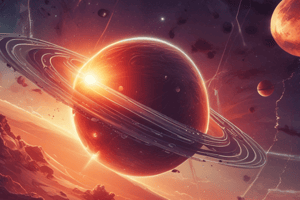Podcast
Questions and Answers
Los __________ orbitan alrededor del Sol
Los __________ orbitan alrededor del Sol
planetas
Los planetas interiores se componen de materiales _________ o metálicos
Los planetas interiores se componen de materiales _________ o metálicos
rocosos
Los planetas exteriores están compuestos principalmente de _______ y helio
Los planetas exteriores están compuestos principalmente de _______ y helio
hidrógeno
Los __________ son fragmentos de roca y metal dispersos por el sistema solar
Los __________ son fragmentos de roca y metal dispersos por el sistema solar
La mayor concentración de asteroides se encuentra en el cinturón de _______
La mayor concentración de asteroides se encuentra en el cinturón de _______
El sistema solar se formó hace aproximadamente 4.5 mil millones de ________
El sistema solar se formó hace aproximadamente 4.5 mil millones de ________
Flashcards are hidden until you start studying
Study Notes
Our Solar System: Planets and Asteroids
The solar system, centered around our star, the Sun, comprises a diverse and expansive array of celestial bodies. Eight planets orbit the Sun, each with their own unique characteristics, along with a plethora of asteroids, dwarf planets, and smaller bodies.
Planets
Clustered in different regions, the solar system's planets are categorized into two main groups:
- Terrestrial Planets: The four innermost planets consist of rocky or metallic materials. They are Mercury, Venus, Earth, and Mars.
- Jovian Planets: The four outermost planets are composed of hydrogen and helium gas and are often surrounded by rings and moons. They are Jupiter, Saturn, Uranus, and Neptune.
Asteroids
Scattered throughout the solar system, asteroids are fragments of rock and metal that coalesced from leftover debris at the time of the solar system's formation. The largest concentration of asteroids lies in the asteroid belt, which lies between Mars and Jupiter. Asteroids range in size from small pebbles to hundreds of miles in diameter.
Formation and Evolution
The solar system's planets, along with asteroids and other small bodies, were formed about 4.5 billion years ago from a dense cloud of gas and dust. As gravitational forces pulled matter together, the Sun formed first, followed by planets, asteroids, and other celestial bodies. The solar system continued to evolve through collisions, gravitational interactions, and other processes.
The solar system is a fascinating example of how gravity can shape the behavior and arrangement of celestial bodies in our universe. Its planets and asteroids, along with other components, are constantly being studied and explored, revealing new insights about our corner of the cosmos.
Studying That Suits You
Use AI to generate personalized quizzes and flashcards to suit your learning preferences.




